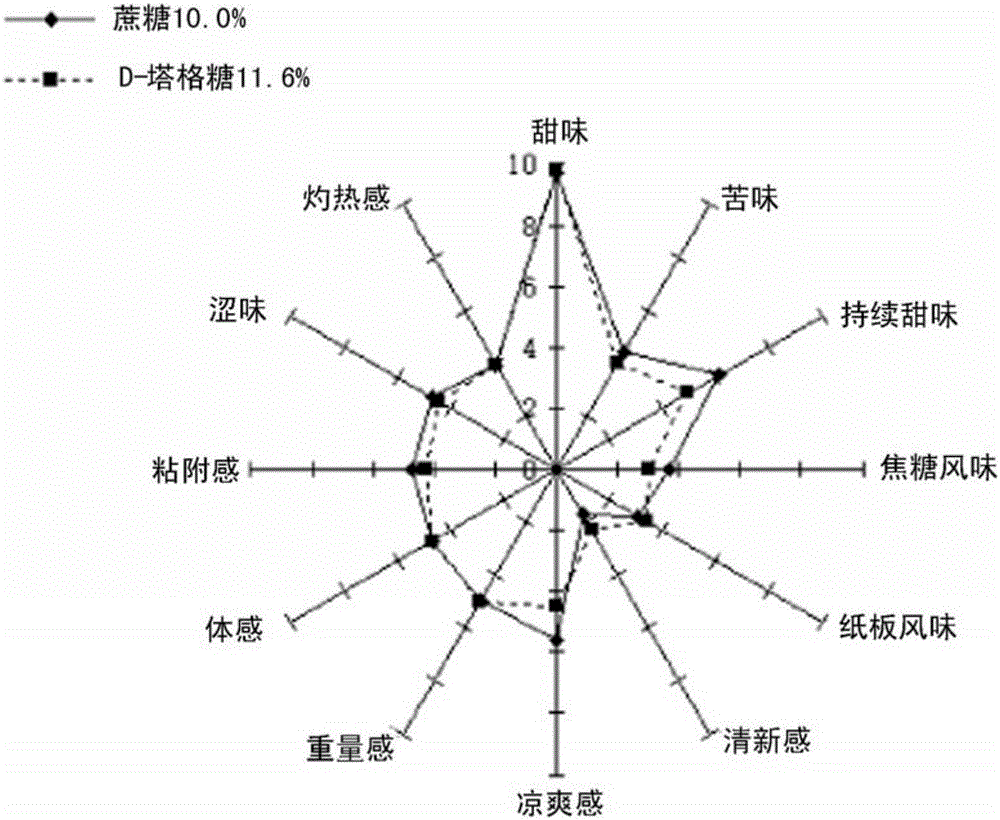Low Caloric Coffee Mix Composition Prepared By Using D-tagatose
A composition and technology of tagatose, applied in the direction of coffee, coffee extraction, application, etc., can solve the problems of bad taste, unsatisfactory, low calorie, etc., achieve good sweetness characteristics, maintain taste quality, and reduce calories
- Summary
- Abstract
- Description
- Claims
- Application Information
AI Technical Summary
Problems solved by technology
Method used
Image
Examples
Embodiment 1
[0023] Example 1: Relative sweetness measurement of D-tagatose and rebaudioside A
[0024] As a first experiment, the sensory properties of D-tagatose and rebaudioside A were determined by measuring the relative sweetness of D-tagatose and rebaudioside A to an aqueous sugar solution using a standard index of sweetness.
[0025] By considering the theoretical sweetness of D-tagatose and rebaudioside A, samples were prepared at various concentrations; the sweetness intensity of each concentration was scored and then substituted into the regression equation. The sensory evaluation was performed as a descriptive analysis by 30 special panelists trained in sweetness cognitive ability. The standard index of sweetness as a control and the investigation results on each of D-tagatose and rebaudioside A are shown in Tables 1 to 3 below.
[0026]
[0027] Standard Guidelines for Sweetness
[0028] evaluation score
2
4
6
8
10
12
14
sugar c...
Embodiment 2
[0043] Embodiment 2: Analysis of sensory properties of D-tagatose
[0044] As a second test, the sensory properties of D-tagatose versus sugar were measured by a descriptive analysis of sensory tests to analyze the sweetness qualities of D-tagatose versus sugar.
[0045] The determination of the concentration of the D-tagatose aqueous solution having the same sweetness recognition intensity as the 10% sugar aqueous solution of the control group was carried out according to the regression equation of the above-mentioned Example 1. Accordingly, the panelists listed sensory descriptive terms for the 10% sugar solution in water and the 11.6% D-tagatose solution, and then defined the commonly identified properties in unambiguous terms. Based on defined terms, the properties of the two sweeteners were compared by giving an intensity score using a scale of 15 points per product.
[0046] result in figure 1 listed in, such as figure 1 As shown in , it can be analyzed that the sug...
Embodiment 3
[0047] Example 3: Analysis of sensory properties of steviol glycosides
[0048] The sensory properties of steviol glycosides relative to sugar were measured by using the same descriptive assay as in Example 2.
[0049] result in figure 2 listed in, such as figure 2 As shown in , steviol glycosides have an extremely long-lasting sweetness and strong bitterness, so that its sweetness is perceived differently from that of existing table sugar. In terms of mouthfeel compared to sugar, the overall mouthfeel is expected to have a sugar-like feel due to its strong astringency, but also its strong body. Considering the organoleptic properties of steviol glycosides, the advantages of high-intensity sweeteners can be maximized when a sweetener having a short duration of sweetness, a slight astringency, and a slight bitterness is mixed in a small amount.
PUM
 Login to View More
Login to View More Abstract
Description
Claims
Application Information
 Login to View More
Login to View More - Generate Ideas
- Intellectual Property
- Life Sciences
- Materials
- Tech Scout
- Unparalleled Data Quality
- Higher Quality Content
- 60% Fewer Hallucinations
Browse by: Latest US Patents, China's latest patents, Technical Efficacy Thesaurus, Application Domain, Technology Topic, Popular Technical Reports.
© 2025 PatSnap. All rights reserved.Legal|Privacy policy|Modern Slavery Act Transparency Statement|Sitemap|About US| Contact US: help@patsnap.com



